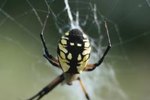
Surrounded by deep blue oceans and adorned with vast, lush landscapes, Hawaii is a tropical paradise and vacation destination. While snakes and spiders are probably not topping the list of things that come to mind when people think about Hawaii, the islands are home to a variety of spiders and only two indigenous species of snakes.
Yellow-Bellied Sea Snake
A distant cousin of the cobra, the yellow-bellied sea snake is a highly poisonous marine reptile that is native to the Hawaiian Islands. Luckily for tourists and the local Hawaiian people, the yellow-bellied sea snake does not pose much of a threat. Sightings of the yellow-bellied sea snake are rare and bites to people are even less common since the slithering swimmer is more timid than aggressive.
Brahminy Blind Snake
With a worm-like appearance, the brahminy blind snake has fooled many people into thinking that there are no land-dwelling snakes in Hawaii. A baby blind snake is only about two inches long and grows to approximately six inches as an adult, making it one of the smallest snakes in North America. Blind snakes are non-venomous Hawaii natives that pose no threat to people.
Brown Tree Snake
The brown tree snake is a non-native, mildly venomous, highly aggressive and unwelcome invasive species of snake that presumably made its way to Hawaii via aircraft from Guam. While only a handful of brown tree snakes have been found to date, brown tree snakes pose a serious threat to Hawaii’s fragile ecosystem. Hawaiian officials strive to protect their native species by carefully screening all incoming aircraft and visitors for snakes and by forbidding locals and visitors from keeping pet snakes of any species.
Brown Violin Spider
Similar in appearance to the brown recluse, the brown violin spider is common to Hawaii. Bites from the brown violin spider are poisonous but rarely fatal. The brown violin spider’s favorite hiding places include woodpiles, loose bark and underneath old boards. Though not particularly aggressive, the brown violin spider has a reputation for biting in self-defense when threatened or disturbed.
Cane Spider
The cane spider, also known as the large brown spider, does not have enough venom to be dangerous to people but is large enough to inspire a substantial amount of dread even in those who are not particularly susceptible to arachnophobia. The average cane spider is about the size of a softball and is not likely to bite a human without provocation. The cane spider would rather hide in crevices than build a web and ventures out at night to hunt.
Crab Spider
The crab spider is commonly found in Hawaiian citrus trees, wooded areas and shrubs. Also known as the Asian spiny-backed spider, the crab spider aggressively defends its web. While a crab spider’s bite is not poisonous, it does pack a painful punch that is best avoided.
Garden Spider
The black and yellow garden spider thrives in Hawaii’s sun-soaked environment. Known for their circular webs with dense zigzag patterns of silk at the center, the garden spider is frequently found in gardens. The garden spider comes in a variety of colors and is totally harmless to humans.
Widow Spider
Hawaii is home to the southern black widow, the western black widow and the brown widow spider. Neither the black widow nor the brown widow spider is outwardly aggressive but both will bite in self-defense. Venom from a widow spider is not lethal but does cause significant pain and discomfort in its victim.
References
- Explore BioDiversity: Reptiles & Amphibians
- Snakes and Spiders: The Brahminy Blind Snake
- United States Department of Agriculture: Animal and Plant Health Inspection Service: Brown Tree Snake: An Invasive Reptile
- Moanalua Gardens Foundation: Wanted: Brown Tree Snake
- Kona Coast Pest Control: Spiders
- Instant Hawaii: Plants & Creatures
Photo Credits
-
Hemera Technologies/AbleStock.com/Getty Images
Writer Bio
Kristina Barroso is a full-time teacher who has been freelance writing since 1991. She published her first book, a break-up survival guide, in 2007 and specializes in a variety of topics including, but not limited to, relationships and issues in education. She earned a Bachelor of Arts in Psychology from Florida International University.




